| Home |
| Acknowledgments |
| Conventions |
| Glossary |
| Maps |
| References |
| Links |
| Articles |
| Thumbnails |
| Species
list |
| Family |
| Next
species |
Additional Photos
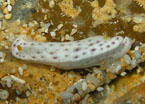
side

dark branchia
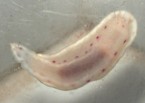
underside
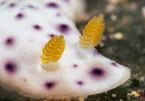
rhinophores

young, 6 mm


predator damage

feeding
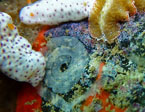
with egg mass _______________
GALLERY

Chromodoris aspersa (Gould, 1852)
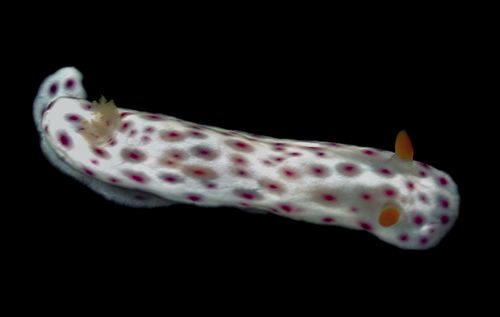
| Maximum size: 30 mm. Identification: This dorid is elongate with a white body and foot covered with magenta spots, most surrounded by a translucent ring. The rhinophores are yellow-orange and the gills vary from pale yellow to orange. Natural history: Chromodoris aspersa is a commonly seen nocturnal species that may be found under rocks during the day. It occurs from the low intertidal to 37 m (120 ft) on rocky bottoms in protected to exposed locations. This is one of the Chromodoris species that deposits its eggs with the ribbon attached by its side rather than its edge (Scott Johnson, pers. com.). It feeds on a violet-black sponge (but, may have a broader diet?). (Note 1). Distribution: Big Island, Maui, Oahu, Kauai, French Frigate Shoals, Midway and Kure: widely distributed in the Indo-Pacific. Taxonomic notes: This species was listed as Chromodoris lilacina (Gould, 1852) in Kay, 1979, Kay & Young, 1969 and Bertsch & Johnson, 1981. The name means "sprinkled." It is referred to as the "purple-spotted nudibranch" in Hoover, 1998 and the "lilac-spotted nudibranch" in Hoover, 2006. It may have been first reported from Hawaii in Kay & Young, 1969. Photo: PF: 19 mm: Makena Landing, Maui; May 11, 2008. Observations and comments: Note 1: Andrea Swagler observed a mature animal feeding on a violet-black sponge with its mouth everted. However, elsewhere in the Indo-Pacific, it's been recorded feeding on a red-orange sponge (see Scott Johnson's site for an example). In addition, two young animals found under a rock were associated with yellow and red-orange sponges that may show feeding damage (though, more ambiguously...). Perhaps, populations differ in diet? Or, it has a broader diet than most chromodorids? |
| Thumbnails |
Species
list |
Family | Next species | Top |